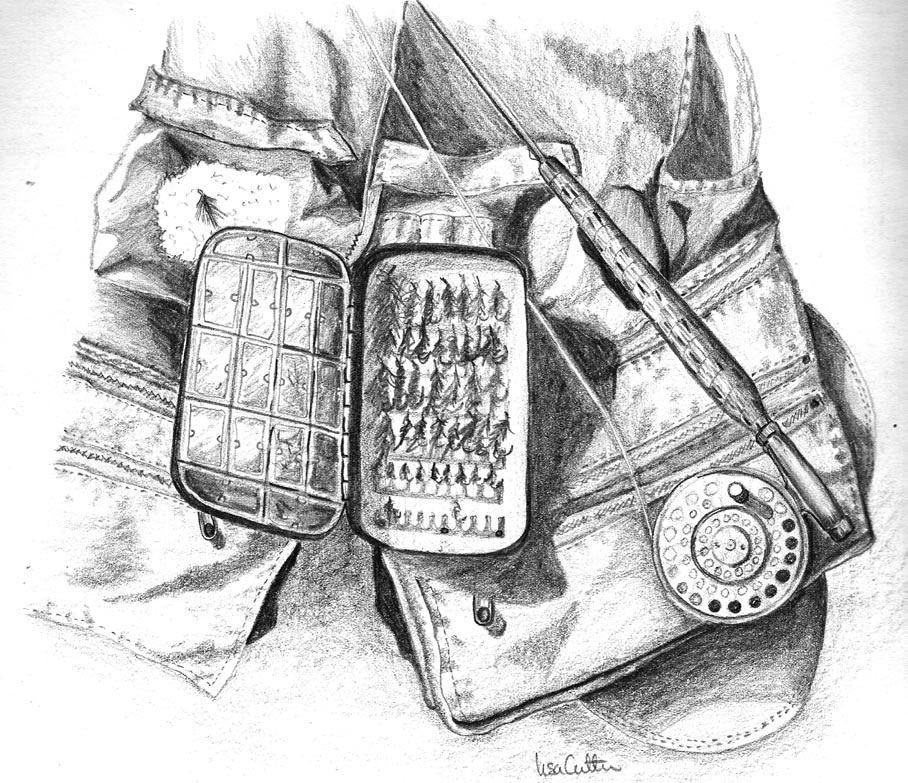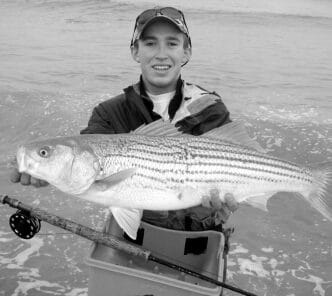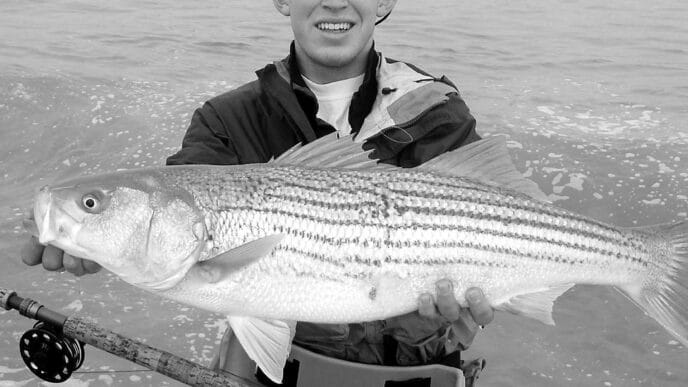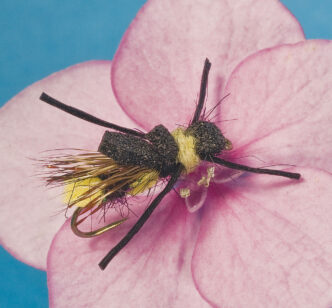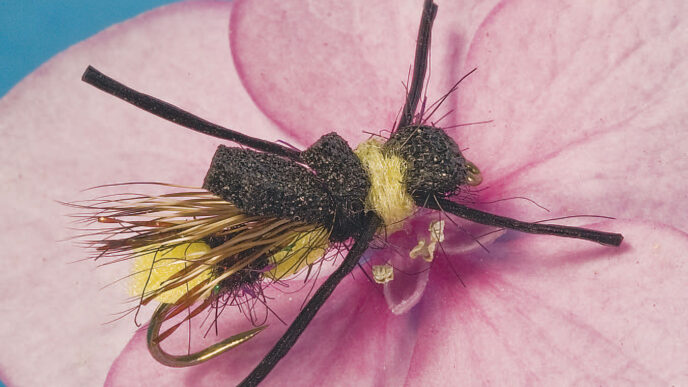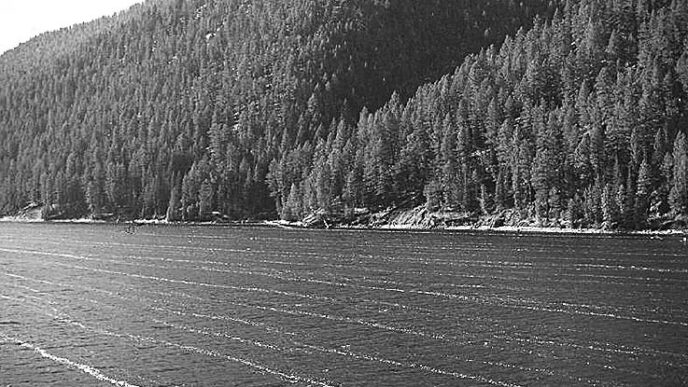Mikey Wier’s new video, Soulfish 2: Fish Mode (see the review in this issue of California Fly Fisher) showcases the difference between old-school and contemporary fishing modes. In the video, I get to play the old guy, wearing garb and using gear from the early fifties. Not until after the shoot was over did I look at a photo of my granddad and realize that I was wearing the wicker creel harness upside down. Being old school has a learning curve.
Old school is as much defined by fashion trends as it is by technological advances. Before Lee Wulff stitched together the first fly-fishing vest in 1931, tackle was carried in chest packs, fanny packs, gas mask bags, and of course, the wicker creel. After World War II, vests became popular and went head-to-head against George Harvey’s cutting-edge aluminum chest pack. By the sixties, the vast majority of anglers had opted out of the various packs and were wearing vests.
Today, fishing vests are considered old school and chest and fanny packs are once again the rage, with sling packs resembling gas mask bags gaining in popularity. I have a love/hate relationship with vests, but have even less affection for chest packs. Some of the rigid foam versions include a flip-out fly-tying bench and are a full six inches thick before a single fly is added. I like to see my feet. Lisa and I have a veritable museum of vests and packs in the garage, and I’m still searching for the Holy Grail. When it comes to carrying gear, I’m still in middle school.
Probably nothing separates old-school fly fishers from newer anglers more than which side of the reel the handle is on. This meaningless debate rages for days and weeks across bulletin boards and blogs. Lee Wulff (the same guy who sewed the first fishing vest) made an argument for left-handed reels back in the thirties. He maintained, as do many today, that the stronger arm should be saved for fighting fish. His argument gained little traction, and right-handed retrieves remained an across-the-industry standard well into the late eighties.
Somewhere in the evolution of standardized fly-fishing instruction, fly-casting instructors discovered it was easier to teach beginners to cast with the right hand and reel with the left, rather than have them switch hands after the cast. An entire generation of anglers now reel left-handed . . . until they hit the salt, where many suddenly discover that their subdominant hand goes spastic after the third run of an albacore.
Flats guides in Mexico have become used to receiving gringos on their first trip to the salt. When the left hand starts bouncing up and down instead of making the reel go in circles, the guide turns the rod upside down and suggests that the angler reel with his right. If industry numbers are any kind of indicator, most of these people come home and buy a right-hand-retrieve reel. According to the latest statistics I can find, 72 percent of reels sold in the 1-to-4-weight category are left-handed, 56 percent in the 6-to-8weight range are left-handed, and 72 percent of the reels in the 12-to-14-weight category are right-handers — the mirror image of the light trout models. By default, Abel ships their 0-to-6-weight reels with left-hand retrieve and anything larger in right-hand mode. (These can be converted to the other hand by the angler.)
I personally try to encourage people to reel right-handed when they enter the sport. The learning curve might be a little steeper, but they won’t be among the nearly three-quarters of the anglers who make the switch after tangling with hot fish. In an ideal world, we should be able to cast and crank with either hand, but that’s a whole other story.
The only place I feel young anymore is at a fly club meeting. Many clubs are dynamic and brimming with enthusiastic young energy, but the rule, rather than the exception, is a room full of old guys hanging out and swapping fish stories. Not my cup of tea, but the very fact that these people share common ground and enjoy each other’s company enough to suffer through endless committee reports and raffles for stuff no one really wants is good enough reason to have a club. So what if some clubs put the “old” into old school? More people should be so lucky as to enjoy and share a common bond.
The modern club is on a computer screen. The meetings run 24/7, and the clubs are hundreds if not thousands of members strong. Ideas are exchanged, goals promoted, and gatherings planned. Fish-outs, fly-tying events, and camping trips are arranged online. Dan Blanton has an international following on his forum, and the board’s annual Striperfest is an amazingly successful multiday fish-out and party that not only is fun, but raises awareness of the plight of the Delta and money needed to combat its foes. It is the modern face of fishing clubs.
Parallel to the course of old-school fishing clubs, old-school fly shops are racing the clock and experimenting with ways to remain relevant. It’s one thing when the typically undercapitalized mom-and-pop store shutters its doors, but when the Reno Fly Shop and Kaufmann’s blink out within four months of each other, it gets kind of scary. The Reno Fly Shop’s website lays the blame squarely at the feet of Cabela’s, Sportsman’s Warehouse, and Scheels, which moved into their home turf. Kaufmann’s points to the Internet as a dominating factor in their demise. The combined mass of big-box retailers, outlet stores, and e-commerce is a heavy load.
Despite the onslaught, many fly shops are not only surviving, but thriving. For example, the American Fly Fishing Company, Leland Fly Fishing Outfitters, and The Fly Shop have embraced the Internet, and Mike Michalak is direct-sourcing high-quality gear and private-labeling everything from hooks and leaders to rods and waders. Kiene’s Fly Shop has developed a huge following of loyal fans and customers with its vastly popular bulletin board. Fly Fishing Specialties and the California Fly Shop go to extraordinary lengths to have every conceivable item in stock and provide lavish customer service that borders on the obsequious (in a good way).
Don’t take the service and convenience of local fly shops for granted. In the 1970s, mountain shops were a dime a dozen. We had three in Tahoe City and two in Truckee, running full tilt, all at the same time. I used to work at one.
We could never imagine they would be gone in a decade, largely due to a blizzard of catalogs from the likes of REI, MSR, and EMS selling a vast selection of gear at impossibly low prices. Today, there are no dedicated mountain shops in the Tahoe area, and the closest is in Mammoth Lakes.
The largest fly shop in the world is eBay. As of early this morning, there was active bidding on nearly five hundred rods. This does not include the seven hundred “Buy Now” rods typically being offered, often at well below suggested retail. How many old-school brick-and-mortar fly shops are going to sell five hundred rods in the next week? More importantly, how can they compete when their inventory is being sold for cost?
Fly shops have become the involuntary testing ground and fitting room for ecommerce and big-box merchandisers. It’s truly a dog-eat-dog industry. Even manufacturers have gotten in on the game by selling direct to consumers and cutting out the very fly shops who invest in marketing their product. It doesn’t make sense to me, but then, consider the source. I’m old school.




